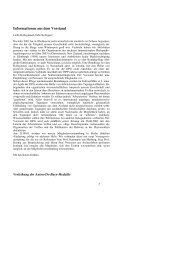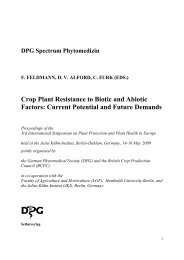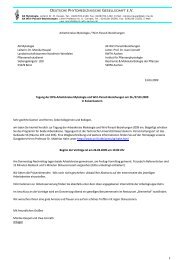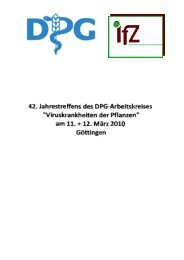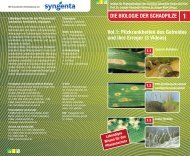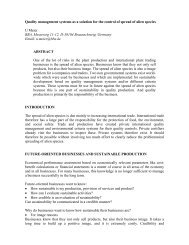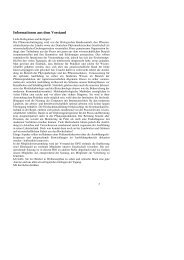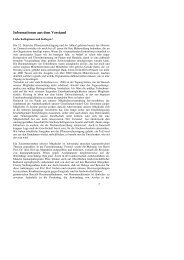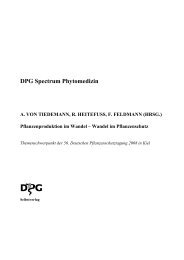PHYTO MEDIZIN Mitteilungen der Deutschen ... - Die DPG
PHYTO MEDIZIN Mitteilungen der Deutschen ... - Die DPG
PHYTO MEDIZIN Mitteilungen der Deutschen ... - Die DPG
Sie wollen auch ein ePaper? Erhöhen Sie die Reichweite Ihrer Titel.
YUMPU macht aus Druck-PDFs automatisch weboptimierte ePaper, die Google liebt.
on the pods for all isolates, while obvious leaf symptoms did not occur in any<br />
combination. These results indicate that this new strain of CPMMV caused<br />
the necrotic spots on the pods of the originally infected plants.<br />
A new bunyaviral-type plant virus is associated with the ringspot disease<br />
of European mountain ash (Sorbus aucuparia L.)<br />
HP Muehlbach, N Mielke, W Benthack and N Schlatermund; Biocenter Klein<br />
Flottbek and Botanical Garden, University of Hamburg<br />
European mountain ash trees (Sorbus aucuparia L.) in Germany suffer from<br />
ringspot and mottling symptoms on leaves and from a gradual decay in general.<br />
We could isolate double stranded RNA (dsRNA) from symptomatic<br />
tissue, which indicates RNA virus infection. Cloning and sequencing of putative<br />
viral RNAs allowed the characterization of a new virus associated with<br />
the mountain ash disease. Fractions of dsRNA were extracted by column<br />
chromatography. A characteristic pattern of dsRNA of approximately 7 kb,<br />
2.3 kb, 1.5 kb, and 1.3 kb, respectively, was found in leaf samples of symptomatic<br />
mountain ash trees from various sites in Germany. No dsRNA was<br />
detected in asymptomatic trees. By random primed reverse transcription,<br />
DOP-PCR (degenerate oligonucleotide primed PCR), cloning and sequencing,<br />
dsRNA-specific cDNA fragments were obtained. Using 5´-RACE analyses,<br />
modified by biotin labelling and magnetic separation, longer cDNAs<br />
could be enriched. With our cloning strategy a cDNA of 7.0 kb in length was<br />
obtained first. The corresponding RNA harbours one ORF with homology to<br />
the RNA dependent RNA polymerase (RdRP) of members of the family<br />
Bunyaviridae. It shows all conserved sequence motifs of the bunyaviral<br />
RdRP and also the typical terminus sequences at its 5´- and 3´-end. Primers<br />
<strong>der</strong>ived from the terminus sequences allowed the subsequent identification of<br />
three further RNAs of 2.3, 1.6 and 1.3 kb. The corresponding ORFs encode a<br />
putative glycoprotein precursor, a putative nucleocapsid protein, and a protein<br />
of unknown function. In situ hybridization studies using digoxigenin<br />
labelled riboprobes for the viral RNA 1 and RNA 3 showed a scattered pattern<br />
of virus accumulation in the mesophyll of mountain ash leaves. The<br />
dsRNA pattern, the sequence information and the present image of the viral<br />
genome organisation strongly indicate that a new plant RNA virus with similarity<br />
to the Bunyaviridae is associated with the mountain ash ringspot disease.<br />
26




